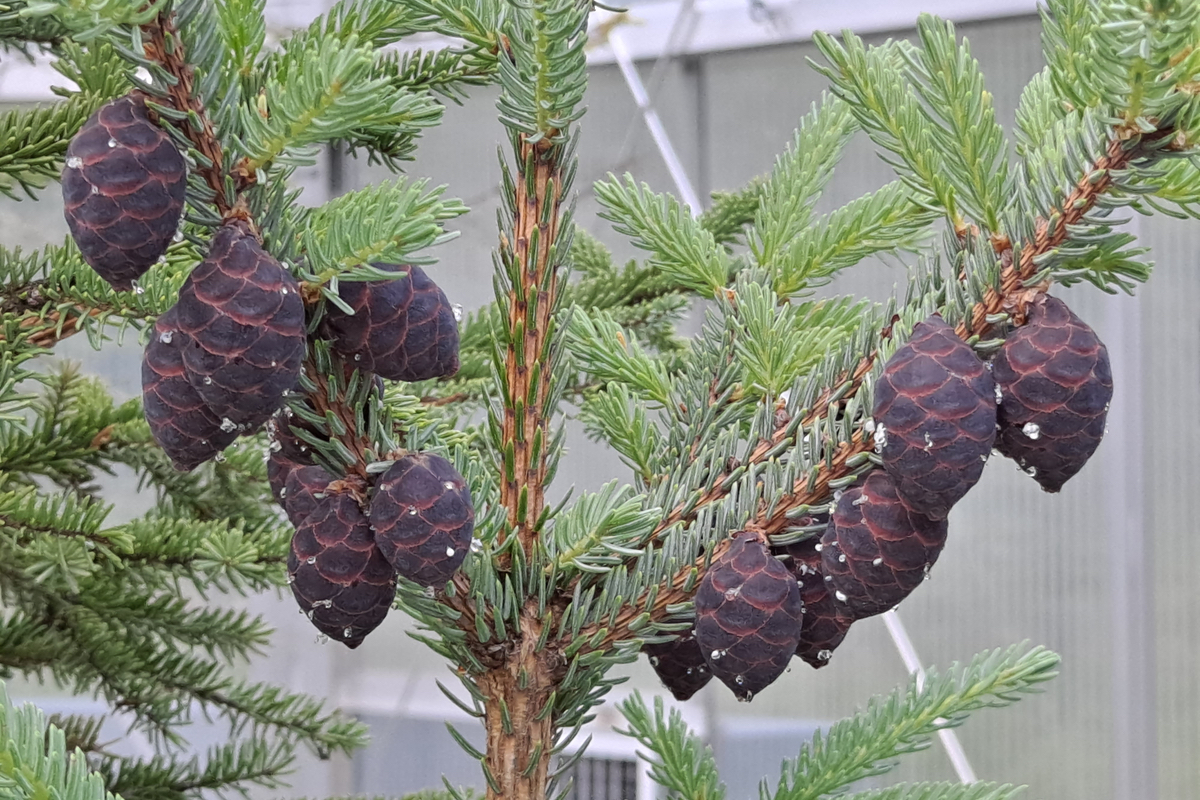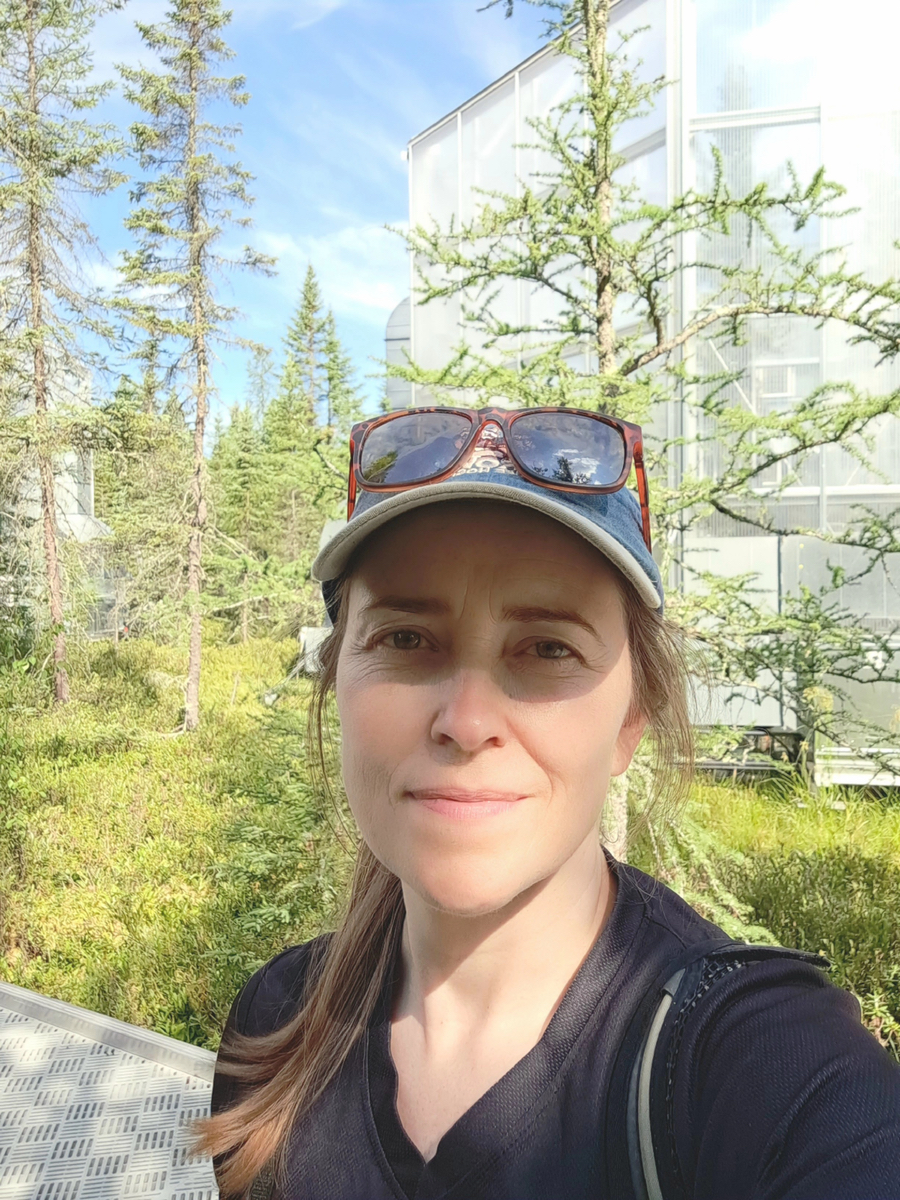 Dark purple cones grow on a black spruce tree, part of an Oak Ridge National Laboratory experiment in Minnesota. (Image courtesy of Jalene LaMontagne)
Dark purple cones grow on a black spruce tree, part of an Oak Ridge National Laboratory experiment in Minnesota. (Image courtesy of Jalene LaMontagne)
In the decade since she joined the DePaul faculty, ecologist Jalene LaMontagne has distinguished herself internationally for research on boreal conifer tree reproduction, including what causes cone production to vary across time and space, and how it affects other species.
Her research, from the forests of Wisconsin, Michigan and Minnesota, all the way to global scales, has improved science’s understanding of trees, especially the patterns and drivers of their reproduction. This critical process affects not just woods but entire ecosystems. Birds and small mammals feed on the seeds that trees produce, while the trees benefit from the regeneration that comes through their reproduction.
Scientists have long understood these patterns of reproduction to vary regionally. A
recent finding, from research led by LaMontagne, established a notable difference between North American trees, depending on whether they are in the east or the west side of the continent. While the patterns are largely synchronous within local populations, LaMontagne has found they are not uniform. In fact, neighboring trees can fluctuate significantly in their seed production.
“Why are individuals close to each other similar or different? Why are different sites or different populations different?” LaMontagne asks. This is part of the puzzle of nature that she is trying to piece together.
To answer these questions and more, two federal agencies have now stepped forward to award her nearly $500,000 in grants.
 Jalene LaMontagne at the Oak Ridge National Laboratory's Spruce and Peatland Responses Under Changing Environments experiment in Minnesota, where she has worked since 2017. (Image courtesy of Jalene LaMontagne)
Jalene LaMontagne at the Oak Ridge National Laboratory's Spruce and Peatland Responses Under Changing Environments experiment in Minnesota, where she has worked since 2017. (Image courtesy of Jalene LaMontagne)
LaMontagne, who was promoted this summer to
a full professor in the Department of Biological Sciences, says she sees these federal agencies as making “an investment in me” to develop new research ideas, leveraging her scientific successes thus far."
The larger grant, for more than $330,000, is a Mid-Career Advancement Award from the National Science Foundation, which has
long sponsored her studies; LaMontagne currently leads three NSF-funded projects. This new award will allow her to team with other scientists to investigate what’s happening belowground as well as up in the air. She’ll also tap into global databases “to try and understand patterns across species and at a really broad scale,” and she’ll bring mathematical modeling to bear on the dynamics of spatial synchrony.
“I teach a course in research methods and applied biostatistics, and I really like the math part of this work,” she says. “I wanted to work with a research partner who does novel statistical approaches that I will learn. That was really an important part of it. At the same time, being able to add a new aspect to my research program, these above-ground/below-ground connections, was important.”
The second grant comes from the U.S. Department of Energy, for almost $150,000. Although it’s a new grantor for her, LaMontagne has been working as a collaborator on the Oak Ridge National Laboratory's
Spruce and Peatland Responses Under Changing Environments experiment in Minnesota since 2017. At the SPRUCE experiment, LaMontagne examines how warming and elevated carbon dioxide affect conifer tree reproduction.
The Biological and Environmental Research program at the Department of Energy supports research on changing environments to understand how future ecosystems will be affected.
"There are whole groups of mathematical modelers trying to figure out: where is all the carbon going in the ecosystem?" LaMontagne explains. "Where are the nutrients going? What’s going to happen to future forests? Right now, plant reproduction is not well represented in those models.”
This grant, funded through the DOE Research Development and Partnership Pilot program, will enable LaMontagne to participate in DOE events and meet with modelers at DOE’s Oak Ridge National Laboratory and Lawrence Berkeley National Laboratory and develop future collaborations to incorporate plant reproduction into their work.
The common thread between these two grants, LaMontagne notes, is that "it’s about new directions for research and building the partnerships.” Adding new skills along with new networks will broaden the reach of her scholarship and perhaps uncover more arboreal mysteries along the way.
Scott Butterworth is an editor of Newsline.